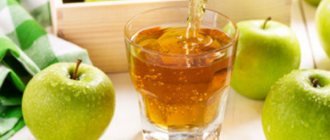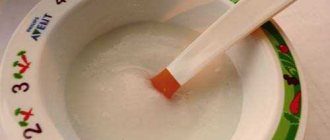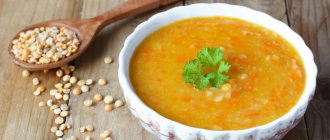What should be the correct complementary foods at 6 months? There is some controversy regarding the timing of introducing additional nutrition for breastfed babies. Many experts are confident that before six months there is no need to introduce additional foods into the baby’s diet. Formula-fed babies can be given complementary foods as early as the fourth month of life.
Features of the age of 6 months
Why can't complementary foods be introduced before 6 months? Some parents think that if the baby is not eating well at 2-3 months of age, then it is urgent to introduce complementary foods, at least a couple of spoons of puree or a small amount of juice. But such an intention can only harm the child’s health. In the future, you may experience health problems such as:
- diathesis;
- allergy;
- development of obesity;
- indigestion.
But late feeding is dangerous:
- lack of vitamins;
- the risk of anemia and malnutrition.
So how to start complementary feeding? How to introduce complementary foods correctly? What should I feed my baby? Until the sixth month, the baby’s stomach is not ready to accept heavier food than breast milk. Each child is individual, so the start time is different for everyone. Perhaps at five months some are ready for new food, while others are only at nine. It is best to consult a doctor and observe the baby yourself. But at 6 months the baby can already swallow. But first of all, you need to pay attention to the following factors:
- sits well enough, no longer spits up;
- there is the ability to pull the lower lip forward to take food from a spoon;
- may turn his head, demonstrating refusal to eat;
- the child’s tongue does not make reflexive pushing movements;
- food from adults is very interesting to the baby;
- asks for milk more often;
- doubles weight;
- the child is healthy, active and mobile.
However, our grandmothers strive to give their babies new food early. Starting from early infancy, they try hard to achieve this. But such an early introduction will not lead to anything good. Make sure you have a routine. We recommend feeding your child five grams per day, increasing the dose per week to 100–150 grams.
Principles of introducing complementary foods:
- Complementary foods from 6 months on breastfeeding should be liquid and warm. Cooking in a double boiler will preserve the beneficial substances in the product.
- feed before lunch;
- Give new ingredients on an empty stomach. Then finish the meal with milk;
- the next ingredient should be taken after adapting to the previous one;
- change the feeding regimen, take a four-hour break between meals.
Moms have questions about the type of product being administered. Which comes first: cauliflower, broccoli or apple? When to give water? What to give at 6 months while breastfeeding? You should go to your pediatrician for advice and, based on his observations, develop your own complementary feeding formula. And also pay attention to the reaction of the child’s body when feeding. If irritation or redness occurs, you should immediately stop feeding this product.
What indicates the toddler’s readiness to change the menu?
At 5 months, complementary foods are introduced to babies who are on artificial nutrition. Breasts may need new food a little later, it depends on the quality of mother’s milk and the individual characteristics of the baby’s body.
You can determine the readiness and need for menu changes based on the following observations:
- The toddler is able to sit independently in a high chair, maintaining the correct body position;
- The baby has already cut his first teeth;
- When feeding, the baby completely eats the contents of the bottle and asks for more by crying for a long time. Children who are breastfed do not get enough of one breast and continue to look for food; after weaning, they become very capricious;
- the child may become restless and whiny, which affects the quality of sleep. He starts asking for food ahead of schedule;
- if there is a lack of necessary nutritional components, the baby stops gaining weight;
- The baby begins to be interested in the contents of the parents' plate, trying to steal something tasty.
All these signs indicate that you can safely introduce new food. Even the presence of several of them should be a reason to consult a pediatrician.
What does the first menu consist of?
How to introduce complementary foods? The choice of the first menu depends on the individual preferences of the baby’s body. The complementary feeding scheme from 6 months is varied. There are two options for feeding your baby new food. The first is gluten-free, dairy-free porridges, which include buckwheat, corn, and rice. The second option is vegetable purees. If your baby is overweight and has constipation, then, of course, it is better to start with vegetable puree. If a child is gaining little weight, then definitely go with porridge, because it contains more calories than 100 grams of liquid milk. You should not mix products, so as not to look for the cause of the allergy or malaise later.
Complementary foods for a 6-month-old baby can be created in various ways. If your choice fell on vegetable purees, then choose cauliflower or broccoli. Then continue adding other vegetables: carrots, potatoes, zucchini. You cannot add sugar or salt to the puree. For kids this will be an early test; it is better to add a drop of vegetable oil or half an yolk, again starting with small doses (a drop or five grams of the product will be enough). Vegetable broths will be useful; meat broths are too early for children’s kidneys.
The tastiest and healthiest thing for a 6-month-old baby will be making soups. Vegetables are chopped in a blender and served. All vitamins and nutrients will be preserved in this form. As for preparing porridges, they are also “destroyed” in a blender, after which they are boiled in water or breast milk, you can add a drop of vegetable oil. And lunch is ready to eat.
The scheme for introducing complementary foods for children who are breastfed or bottle-fed can be varied.
Let's look at one of them in the tables:
| Age | Products |
| 6 months | Vegetables |
| 7 months | Zucchini, dairy-free porridge |
| 8 months | Meat, potatoes |
| 9 months | Cottage cheese, kefir |
| 10 months | Fruits |
Complementary feeding table.
| Days | Norm |
| First | 5 g |
| Second | 10 g |
| Third | 20 gr |
| Fourth | 40 gr |
| Fifth | 80 gr |
| Sixth | 115 gr |
| Seventh | 140 gr |
| Eighth | 5 g |
| Ninth | 10 g |
If a 6-month-old baby is not satisfied with the food you offer him, do not insist. So this is enough for him. Potatoes are best introduced at the age of eight months, because they are much harder for the young gastrointestinal tract to digest than breastfeeding.
Right time
Your baby is six months old and is eating breast milk. Should I feed him cereal? The answer from specialists will be definite - a child at six months must be introduced to the menu with vegetable and fruit purees, juices and compotes. You should also introduce him to cereal crops.
How to understand that a breastfed baby is ready to receive complementary foods, and what is the correct rate?
Signs that a child is ready to receive additional nutrition include:
- interest in pieces of food on mother’s plate;
- signs of teeth in a baby;
- when the child sits up on his own;
- ability to hold a spoon in your hand.
At three months, the body begins to prepare for the transition to adult nutrition and produces hydrochloric acid. At the same time, the intestines begin to transform, the walls of which become less permeable to liquid food. All these transformations occur at approximately the same time, but taking into account the individual structure of the baby’s body on artificial and mixed nutrition and genetic characteristics.
The World Health Organization (WHO) strongly recommends introducing first complementary foods no later than 6 months of age.
How to introduce porridge
You can start introducing complementary foods to your baby in the form of porridge at the age of 7 months. It is too early to give cow or goat milk, as there is a risk of intestinal diseases. Gluten contained in cow's milk can cause gastrointestinal disease (celiac disease). You can make porridge yourself using water or buy it ready-made in a store or pharmacy, but it must be dairy-free and gluten-free. After this, carefully monitor how the body reacts to this product, whether there are any allergies or constipation. Only after good absorption can you continue to feed with another type. It is important to know that an allergic manifestation occurs after increasing the volume of the product. Therefore, you need to introduce the first complementary foods carefully, observing every week the body’s reaction and the child’s growth.
Homemade or store-bought delicacy, what to choose?
If you introduce complementary foods at 5 months in the form of vegetable purees, then zucchini, cauliflower, potatoes, pumpkin or carrots are given first. When choosing ready-made store products, you must follow the following rules:
- One-component types should be the first to be present on the baby’s menu;
- after familiarizing yourself with one vegetable for one week, you need to introduce a spoonful of a new product into your usual dish;
- It is necessary to increase the volume of puree daily, but only after the baby eats the contents of the spoon with appetite. If the little one doesn’t like the new food and spits it all out, then the next day they offer the same dish and in the same quantity.
You cannot store an open jar for a long time. After feeding, the remainder must be disposed of. Therefore, many mothers, introducing complementary foods from 5 months, prefer to prepare purees on their own. But for this you need:
- carefully select purchased products;
- peel the peel before use;
- when preparing vegetable dishes, they resort to baking or boiling;
- You need to wipe the prepared ingredients for the puree until the mixture becomes homogeneous, without lumps and fibers.
The decision regarding the choice of a homemade or store-bought product remains with the parents. The advantage of purchased puree is:
- no need for cooking;
- ideal composition, all components are selected in combination with the needs of the baby;
- The consistency of the dish is homogeneous without the presence of lumps and ungrinded pieces.
The disadvantage of feeding a 5-month-old child with purchased products is the high price and the need to dispose of the remainder of the jar at the initial stage of the puree being introduced.
The advantage of a dish prepared at home is that the food will be fresh and you can immediately make the right amount of puree. The main disadvantage is the waste of time cooking and chopping vegetables.
Complementary feeding at 8 months
At eight months, the baby is ready to eat potatoes, meat, and yolk. It is better to give potatoes a little later because they are very allergenic. It is better to start with five grams, increasing the dose to 150 grams by the end of the week. A drop of butter will not harm a young body. As for the yolk, it is best to feed it with quail. Quail yolks are considered healthier and less allergenic. On the first day, give a couple of crumbs, on the second - ½ halves, then half and ½. The easiest way is to mix it into breast milk. From meat puree, it is preferable to give turkey or chicken first; these products are easier to digest. Then veal (by nine months), and pork the later, the better (1–1.5 years). Everything is introduced according to the same scheme, the amount does not change - from 5 grams to 150. If the baby refuses meat puree, add the product familiar to feeding the child - broccoli, carrots.
We recommend using this easy meatball recipe to prepare fresh daily soups. We grind the meat without any additives in a meat grinder, then make balls and put them in the freezer. If necessary, remove from freezer, steam along with vegetables and grind in a blender. Such balls will not stick together in the future.
Signals that it’s time for your baby to introduce complementary foods
By carefully observing your child, you can understand that it is time to introduce the first complementary foods:
- The baby often wakes up at night, nurses for a few minutes, and then starts crying.
- The baby “snacks” too often (if you put him to the breast more than 12-15 times a day, then most likely he does not eat enough). It is recommended to consult with a specialist and choose an adapted milk formula (and in some cases also introduce the first complementary foods).
- The baby is not gaining weight well. According to doctors, if a child gains less than 100-120 g per week, it is worth visiting a pediatrician. If we are talking about a premature baby (or a baby who was seriously ill during the newborn period), then you should not start complementary feeding until his weight triples (compared to his body weight at birth). This is the norm, so there is no need to rush into introducing food.
- The child is on mixed feeding, and most of it is artificial. The fact is that even though infant formula contains all the necessary vitamins and minerals, the child’s need for nutrients increases every month. And closer to the age of six months, such nutrition is not enough for him (in particular, calcium and iron).
Another sign that it is time for the first complementary feeding, according to older family members, is breastfeeding at night. They believe that their grandson or granddaughter does not eat enough, so he needs to be given an apple or porridge. In addition, they claim that adult food will help the child sleep better at night. But there is nothing alarming about night feedings. This is the time when the baby needs his mother, and depriving the baby of this is too stupid. As for improving sleep, many parents regretted introducing complementary foods ahead of time. As one mother admits, after adding buckwheat porridge to breast milk, the baby suffered from tummy pain and constipation for several days.
Complementary feeding at 9 months
During this period, you can carefully introduce fermented milk products and cottage cheese. We buy cottage cheese without additives, fruits, or fillers; it’s better if it’s children’s cottage cheese Tyoma or Agusha. We also start with 5 grams and increase to a portion of 50 grams by the end of the year. It’s better not to take grainy cottage cheese. As for kefir, it is better to give it two hours before bedtime in a volume of 5-10 ml. Kefir should be without flavoring additives. Administer in portions the same as cottage cheese, and by the age of one year, increase the dose to 200 ml. If your baby is fed kefir and he refuses to drink it, don’t be upset. Some mothers try to add sugar to this drink, which is not recommended. It is worth postponing this event for a week, then try again. If the child doesn’t want to, don’t worry. Some children will never eat it, but will develop no worse than their peers.
Complementary feeding at 10 months
Some infants develop teeth by 10 months, and can safely be given a piece of fruit. The best complementary foods would be an apple or, alternatively, applesauce. We also start with half a spoon, bringing the portion to 150 g. Sometimes mothers give their baby fruit puree as complementary foods from 6 months, but this is not necessary, because the beneficial microelements contained in it are found in breast milk or dry formula. Fruits, as a source of nutrition, are a delicacy that irritates the gastric mucosa. Store-bought juices are especially useless. Now pediatricians recommend giving juices after the introduction of main complementary foods, that is, no earlier than 7 months. In general, juices are a difficult product for the gastrointestinal tract, as they contain a lot of acid, vitamin C and sugar. As for drinking, from seven months it is preferable to give herbal tea or water.
How to make puree tasty and sweet
Before introducing porridge, you can offer your baby fruit puree. The first fruits chosen are green apples. Before cooking, they are washed, peeled and baked in the oven, adding a little water to the container. The pulp is selected from the finished apples and ground in a blender. This puree turns out sweet and tender. Once your baby is accustomed to the apple, you can add this component to the porridge.
If your toddler doesn’t eat vegetables well, pumpkin helps improve the taste. It also makes a sweet puree. The description of the cooking process is almost the same, except that the vegetable is cut into small pieces before baking. Pumpkin cleanses the body well of harmful substances, but you should not get carried away with it, so as not to provoke loose stools.
Problems of the complementary feeding period
What problems may arise when introducing a new food? This is an allergic reaction, constipation or, as the opposite, diarrhea. The baby becomes capricious and is bothered by colic in his stomach. To avoid continuation, stop taking the new product for a period of 1-2 months. In the future, take a new product after consulting your pediatrician. Monitor your baby's health. If the baby is active and healthy, but after several months he does not eat complementary foods, do not be upset, the child’s body knows best what is suitable for him. Perhaps the enzyme system has not yet formed. Therefore, do not stuff your child at 6 months, but give him a break and try again.
Mothers often argue which is better: food in jars or freshly prepared food. There is no consensus. Both sides are right in some ways. Canned food was invented to save maternal time and give mom a rest, but for this you need to check:
- expiration date on jars;
- composition (there should be no additives, salt, sweeteners).
What is best not to give to children under one year of age:
- juices (the acids contained in them only irritate the mucous membranes, but have no effect);
- cereals with glutagen;
- fresh vegetables (cucumbers, tomatoes);
- chocolate, waffles;
- cow's, goat's milk or any dairy product;
- "overseas" fruits.
Mom needs to remember the rules of complementary feeding:
- begin to introduce new foods correctly and evenly, since later this “hasty” can adversely affect the child’s health;
- it is advisable to start giving water from the beginning of complementary feeding so that the baby does not become constipated;
- monitor the condition of the skin and the reaction from the abdomen;
- do not schedule vaccinations;
- start with a one-teaspoon serving;
- It is recommended to start complementary feeding with ready-made baby food;
- spices, salt, sugar should not be given to a child at such a young age. For us, not salted zucchini will seem like a terrible food, but for the baby it will be an excellent and healthy treat. The little man's kidneys are not ready for such a load;
- Complementary feeding of a child means adding missing vitamins and microelements to the baby’s diet, but not pampering, so “don’t reinvent the wheel,” but once again consult a specialist;
- if the child is against your proposed product, do not insist, but give in and take a break.
Recipes for a 6 month old baby
At the age of six months, most babies already sit more confidently. The nutrition of a 6-month-old child on breastfeeding or on artificial feeding is not much different. You can cook according to the same recipes, adhering to the individual characteristics of the crumbs.
Cook or buy?
When the time for complementary feeding approaches, parents wonder what is better, buying or preparing it themselves.
Store-bought meals have several advantages:
- Quick and easy preparation;
- Convenient to transport;
- Safety. During production, the quality of products is carefully checked;
- Products are ready at the right time.
You can also cook it yourself, it makes it easier to stick to the required amount of ingredients. Cooking your own food is also much cheaper. Some of the benefits of making your own meals include nutritional value. Homemade food turns out to be richer and more expressive in taste.
It is better to prepare complementary foods for your baby yourself
Vegetable purees
To make your own puree, you need to choose only fresh products. Store-bought vegetables should be soaked in water before cooking to remove nitrates. Soaking time is 1-2 hours, for potatoes up to 24 hours.
To prepare vegetable puree, you need to take the desired product, chop it finely, and cook until tender. Then, while warm, beat with a blender until smooth, add water or mixture if necessary. You can add a small amount of oil and salt.
Meat puree
The meat is carefully processed, veins, bones, and fat are removed, then boiled for 1.5 hours. Then it is crushed with a blender or meat grinder and finally ground through a sieve. To ensure that the meat is not dry, breast milk, formula, porridge or vegetable puree are added to it.
To prepare meat puree, you need to choose low-fat varieties, such as turkey, chicken, rabbit.
When boiling meat or preparing puree, do not season with spices or salt.
Fruit puree
To prepare fruit puree, you need to take products that do not cause gas formation and allergies. Prepares like a vegetable. You can add sugar or honey to the finished puree for taste.
Many fruits contain allergens; first you need to give a teaspoon of puree and observe the child’s reaction. If the body reacts normally, you can give it in larger quantities.
Porridge
When choosing cereals, you should pay attention to the fact that rice coats the stomach and strengthens the stool, buckwheat and oatmeal contain fiber and have a laxative effect, corn is neutral. Porridges can be alternated or mixed with each other. You can also add vegetables and fruits to them for taste.
At first, you need to cook liquid porridge at the rate of 1 tsp. crushed cereal per 100 ml of water. After a week you can cook it thicker, 2 tsp. cereal flour per 100 ml of water. Add butter and salt in moderation; it should taste under-salted.
Before pouring the cereal flour into the pan, it should be diluted in cold water and then poured into boiling water.
For porridge, it is better to use buckwheat, rice or corn grits.
Soups
Rice soup
- 10 g rice,
- 150 ml milk,
- 200 ml water,
- 3 g butter,
- Sugar,
- Salt.
Cook the rice (so that it is well cooked and soft), rub it through a sieve, adding milk.
Add a little sugar and salt and boil again. Stir oil into the finished soup. Vegetable soup
- 20 g cabbage,
- 20 g potatoes,
- 10 g carrots,
- 100 ml water,
- 50 ml milk,
- 5 g butter,
- Salt.
The products must be thoroughly peeled and washed, then finely chopped. Place vegetables in a saucepan, add water, cook until tender. While the vegetables are hot, grind them through a sieve along with the broth, add hot boiled milk, butter, and salt. Mix everything and bring to a boil again.
Juices
Juices can be prepared from fruits and vegetables for complementary feeding. To prepare them, you need to rinse the vegetable or fruit well, then pour boiling water over it to sterilize. Next, grate on a fine grater, wrap in gauze and squeeze. If you have a juicer, you can pass the product through it and get juice.
Concentrated juices should not be given to young children. Before use, freshly squeezed juice must be diluted with cold boiled water in a 1:1 ratio.
Fruit and vegetable juices are good for children
Cottage cheese
To make cottage cheese you will need kefir. From 300 ml of kefir you will get 50 g of cottage cheese.
Kefir must be poured into a saucepan and heated over low heat until it curdles. When the whey separates, the mass should be cooled and poured into a colander lined with gauze. The whey will drain and the curd will remain in the colander. To obtain a more uniform consistency, it can be crushed.
Cottage cheese is stored in the refrigerator for no more than 2-3 days. For very small children, it is better to prepare a fresh product every time.
Food in jars
Since your baby needs to be given only freshly prepared food, it is not always possible to cook before each feeding. In this case, store-bought food in jars comes to the rescue.
Before feeding your baby puree from a jar, it should be heated in a water bath. To do this, you need to transfer the desired portion into a separate container and place it in hot water for a few minutes. Can also be reheated in the microwave. After heating, you need to mix the contents, check the temperature and feed the baby. The unheated remainder can be stored in the refrigerator for no more than a day.
Reheated food should not be consumed.
When purchasing ready-made baby food, you should give preference to trusted manufacturers
Summary
Mother's milk is undoubtedly the best source of nutrition for a baby. However, liquid food has a certain concentration of energy, where there is a certain number of calories. The thicker the food, the higher its energy content. For the health of the baby, it is necessary to start complementary feeding at 6 months, and for “artificial” ones from four to five months. Mothers who start giving complementary foods earlier are “fundamentally” wrong. The child’s gastrointestinal tract is not yet ready to digest such heavy food. It seems to you that you can fill the baby’s body with useful substances and vitamins, but in fact it will cause harm. New food is introduced in small portions, one teaspoon at a time. The break between meals becomes longer, about 4 hours. It is important to follow the child’s feeding regimen and consult with a pediatrician about where to start and other issues of interest.
Follow the simple rules of the first complementary feeding when breastfeeding, the scheme from 6 months of which is discussed in this article, and you will succeed. Don't forget that your positive attitude is passed on to your baby.
The benefits of vegetable puree: cooking at home
To prepare puree for the first feeding, take one type of vegetable. Rinse thoroughly and chop finely. Pour in a small amount of water so that it barely covers the vegetables. Simmer for 10-15 minutes. Then puree the mixture in a blender until smooth.
After the baby has gotten used to the new vegetables, you can mix several types. The table will tell you what vegetables a baby can eat at the first meal.
| Vegetable | Useful elements | Action | Peculiarities |
| Potato | Thiamine, potassium and phosphorus, beneficial amino acids | Removes excess fluid and table salt from the body, improves metabolism | High-calorie product - contains 2-3 times more calories than other vegetables. |
| Cauliflower and broccoli | Vitamins C and B, folic acid, a full set of macroelements (iron, zinc, etc.) | Ensures normal growth and development, prevents cancer, protects against viruses | The hypoallergenic product, unlike fresh cabbage, is easier to digest and does not cause bloating in the baby |
| Pumpkin | Vitamins B, C and PP; potassium and copper | Ensures the functioning of the intestines and digestion, removes excess fluid from the body | Low-calorie product, but the keratins in the composition can cause allergies! |
| Zucchini | Vitamins B, C and E; sodium, magnesium, phosphorus, calcium, zinc | Normalizes intestinal function, cleanses the body and removes toxins, activates the growth of the newborn | A dietary and hypoallergenic product, it will be an excellent replacement for beets if you are allergic to the latter. |
| Carrot | Vitamins A, B, C, E and PP | Improves the condition of skin and hair, maintains visual acuity, strengthens the immune system, promotes bone growth | Beta keratin in the composition can cause allergies! |
When preparing purees for six-month-old babies, it is not recommended to use onions, beets, eggplants, tomatoes, cucumbers and white cabbage. Such vegetables can be introduced into the menu after 10-12 months.
Purees are started with ½ teaspoon and supplemented with breast milk or high-quality formula. The dose is gradually increased to 150-200 grams. This corresponds to the standard portion of one feeding. Increase each dose to twice the previous dose. Don't forget to monitor your baby's reaction!










